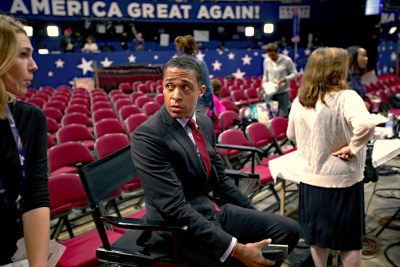Some places become so connected to the shows that broadcast from them that it’s impossible to imagine one without the other. For 26 years, Good Morning America and Times Square have been inseparable, creating morning television magic in the heart of New York City while millions of Americans started their days watching the energy and excitement that only comes from broadcasting live in the crossroads of the world.
That magical connection officially ended this week as GMA broadcast its final shows from the Times Square studio that has been home since 1999. The move to Disney’s new downtown headquarters represents more than just a change of address, it’s the end of an era that defined morning television and created countless memories for both the show’s hosts and the millions of viewers who felt like they were part of the Times Square experience.
The emotional weight of leaving such an iconic location was evident as co-anchors Robin Roberts, George Stephanopoulos, Ginger Zee, Lara Spencer, and Michael Strahan reflected on their years in the studio that made them household names and turned their morning show into a cultural institution that extends far beyond television.
The studio that made morning television history
When Good Morning America first began broadcasting from Times Square on September 13, 1999, with tennis legend Serena Williams as the first guest, it represented a revolutionary approach to morning television. Instead of broadcasting from a sterile studio tucked away in some corporate building, GMA chose to plant itself in the middle of the most vibrant, chaotic, and energetic location in America.
The decision to broadcast from Times Square transformed not just the show, but the entire morning television landscape. Suddenly, morning shows became events that people could witness in person, creating a connection between television and live entertainment that had never existed before. The studio’s glass walls allowed tourists and New Yorkers alike to become part of the show, creating an energy that translated through television screens across the country.
Over the past 26 years, that Times Square studio has witnessed some of the most memorable moments in morning television history. From breaking news coverage that kept America informed during national crises to celebrity interviews that became cultural touchstones, the studio has been the backdrop for countless moments that shaped how Americans start their days.
The location also became a tourist destination in its own right, with visitors from around the world making pilgrimages to Times Square specifically to catch a glimpse of their favorite morning show hosts and maybe even appear on television themselves. That symbiotic relationship between the show and the location created something special that can’t be easily replicated in a new setting.
The hosts who grew up in the spotlight
For the current team of GMA hosts, the Times Square studio represents much more than just a workplace, it’s where they became the television personalities that America knows and loves. Robin Roberts’ reflection about being a little girl from Mississippi working in Times Square captures the magical quality of the location and what it represents for people who dream of making it in television.
Ginger Zee’s memory of pulling up to the stoplight on 44th Street and thinking about how surreal her life had become shows how the Times Square location served as a constant reminder of the extraordinary nature of their careers. When you work in Times Square, you’re reminded every single day that you’re at the center of the entertainment universe.
The hosts have essentially grown up in public from that Times Square studio, sharing their personal and professional milestones with viewers who have watched them evolve over the years. That kind of intimate connection between hosts and audience is rare in television, and much of it was fostered by the unique energy and openness of the Times Square setting.
The emotional difficulty of leaving such a meaningful location is evident in their reflections, with Lara Spencer’s comment about missing the studio so much highlighting how deeply connected they’ve become to the physical space where they’ve spent so much of their professional lives.
What Times Square loses when GMA leaves
The departure of Good Morning America from Times Square represents a significant loss for the iconic area that has already seen many changes over the past few decades. Times Square has been gradually shifting from the gritty, authentic entertainment district it once was to a more sanitized, corporate-friendly tourist destination, and losing GMA continues that transformation.
The morning show brought a level of legitimacy and cultural relevance to Times Square that helped balance the area’s reputation as a tourist trap. Having a respected news program broadcasting live from the heart of the district every morning demonstrated that Times Square remained a place where important things happened, not just a theme park for visitors.
The show also brought thousands of visitors to Times Square specifically to see the broadcast, contributing to the area’s economy and maintaining its status as a must-visit destination. The loss of that daily draw could affect local businesses and the overall energy that makes Times Square special.
Beyond the economic impact, GMA’s departure removes one of the last authentic broadcast operations from Times Square, further homogenizing an area that used to be defined by its unique mix of entertainment, news, and cultural programming. The corporate sanitization of Times Square continues with each departure of long-standing entertainment institutions.
The Disney corporate strategy behind the move
The relocation of Good Morning America to Disney’s new headquarters at 7 Hudson Square in downtown Manhattan reflects broader corporate strategies that prioritize efficiency and control over location authenticity and cultural significance. Disney’s decision to consolidate all its ABC News operations in one state-of-the-art facility makes business sense but comes at the cost of the unique character that made GMA special.
The new Robert A. Iger building represents Disney’s vision of a collaborative media hub where different shows and operations can work together more effectively. Shows like Live with Kelly and Mark and The View have already moved to the new location, creating a media campus that serves Disney’s operational needs while eliminating the distributed approach that gave each show its own distinct character.
From a corporate perspective, the move allows for better resource sharing, more efficient production workflows, and tighter control over content creation. The new facility includes three large studios and state-of-the-art technology that probably surpasses what was available in the Times Square location.
However, the corporate efficiency gains come at the cost of the authentic connection to New York City culture that made GMA special. Broadcasting from a corporate campus in downtown Manhattan, no matter how well-designed, will never replicate the energy and spontaneity that came from being literally in the middle of Times Square.
What viewers can expect from the downtown move
The transition from Times Square to downtown Manhattan will inevitably change the character and feel of Good Morning America, even if the hosts and producers work hard to maintain the show’s energy and appeal. The new studio environment will be more controlled and predictable, which could benefit production quality but might sacrifice some of the spontaneous magic that made the Times Square years so memorable.
The downtown location will eliminate the constant visual reminder that the show is broadcasting from the heart of New York City’s entertainment district. While the new studio will undoubtedly be more technically sophisticated, it won’t have the same connection to the city’s energy and cultural significance that Times Square provided.
Viewers who have become accustomed to seeing Times Square crowds and street energy as part of the GMA experience will need to adjust to a more traditional studio setting. The show may lose some of its unique identity as the morning program that brought viewers directly into the excitement of New York City.
The production team will likely work to recreate some of the energy and accessibility that defined the Times Square years, but the controlled corporate environment of the Disney campus will present challenges in maintaining the authentic connection to the city that made GMA special.
The end of an era in morning television
Good Morning America’s departure from Times Square marks the end of one of the most successful experiments in morning television history. For 26 years, the show proved that broadcasting from an iconic location could enhance rather than distract from serious journalism and entertainment programming.
The Times Square studio became a symbol of morning television’s evolution from purely functional news programming to entertainment experiences that engaged viewers on multiple levels. The show’s success in that location influenced how other programs think about the relationship between setting and content.
The move also represents broader changes in the media industry, where corporate consolidation and efficiency often take precedence over the unique characteristics that make individual programs special. The trend toward centralized media campuses may be economically rational but could homogenize television programming in ways that reduce its cultural significance.
For viewers who have spent decades starting their mornings with GMA from Times Square, the end of this era represents a loss of familiar comfort and authentic connection to New York City culture. While the show will undoubtedly continue to be successful, it will never quite be the same without the energy and authenticity that only Times Square could provide.
The morning that changed forever
GMA’s final week at Times Square represents the end of one of the most successful location-based broadcasting experiments in television history. The show’s 26-year run in the heart of New York City created a unique form of morning entertainment that combined serious journalism with the energy and excitement of America’s most iconic intersection.
The move to Disney’s downtown corporate campus may provide operational efficiencies and technical improvements, but it cannot replicate the authentic connection to New York City culture that made GMA special. The show’s departure from Times Square removes one of the last genuine entertainment institutions from an area that has been steadily losing its authentic character to corporate homogenization.
For millions of Americans who have started their days with Good Morning America from Times Square, the end of this era represents a loss of familiar comfort and genuine connection to the energy of New York City. While the show will continue to inform and entertain from its new location, the magic of broadcasting from the crossroads of the world can never be truly replaced.


















